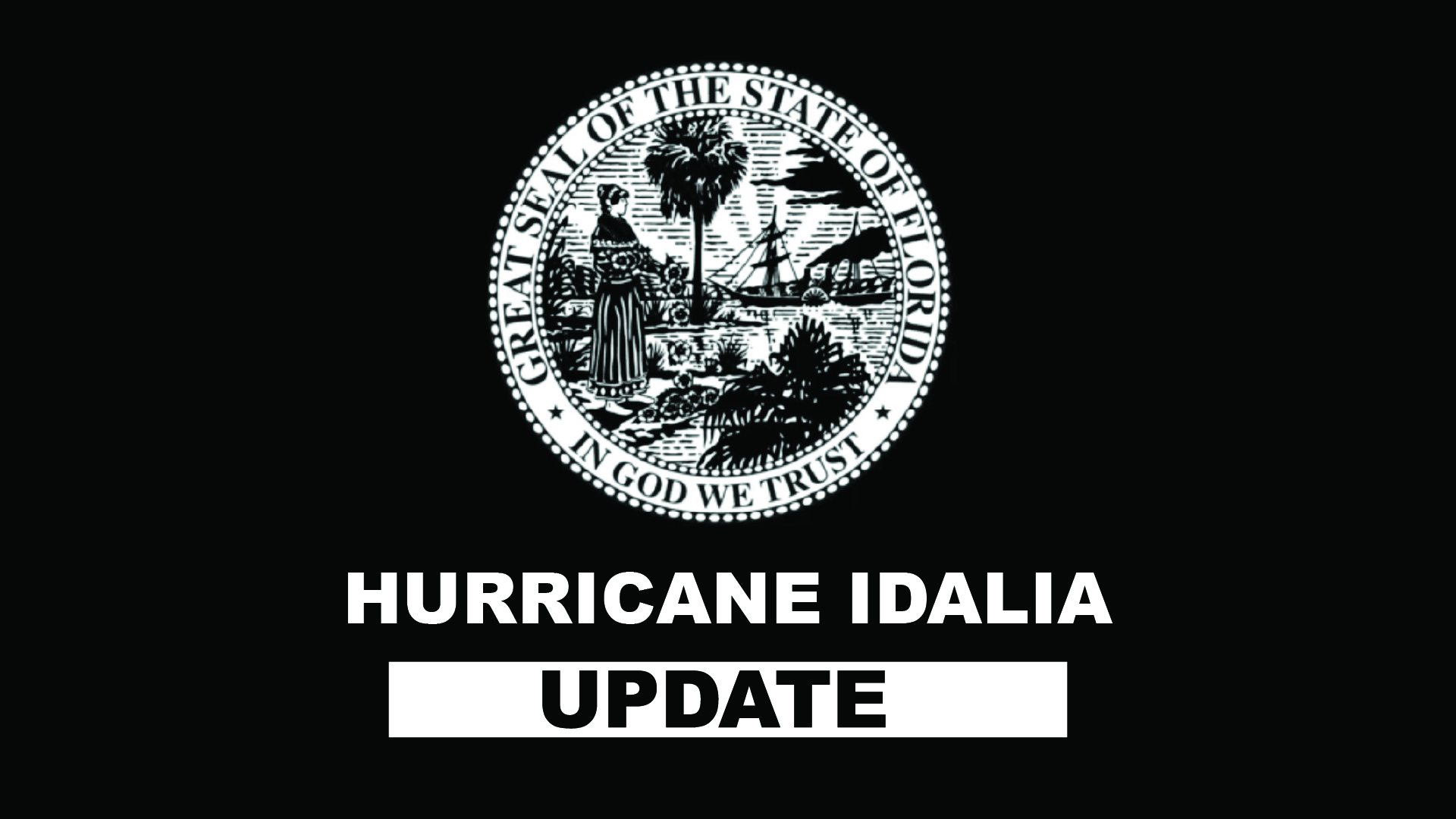Highlights Historic Response and Ongoing Recovery Efforts
TALLAHASSEE, Fla. — Today, Governor Ron DeSantis provides updates on recovery on the one-year anniversary of Hurricane Ian making landfall in Southwest Florida and highlights the long-term recovery efforts over the last year. Hurricane Ian made landfall on the coast of Cayo Costa on September 28, 2022, as a strong Category 4 hurricane. Hurricane Ian was the fourth largest storm to hit Florida and has been one of the largest recovery missions in state history.
The state mobilized a massive effort to prepare resources before Hurricane Ian made landfall, which were deployed immediately following the storm. This included more than 42,000 linemen who were staged to assist in power restoration efforts, along with 5,000 National Guardsmen and all eight Urban Search and Rescue Teams to help with immediate search and rescue efforts. Additionally, the Florida Division of Emergency Management had staged millions of meals and nearly two million gallons of bottled water in preparation for distribution to impacted areas.
To date, over $1 billion in Public Assistance funding has been obligated to Florida communities in response to the devastating impacts of Hurricane Ian. This is in addition to nearly $9 billion in Critical Disaster Relief funding that has been paid out to local communities impacted by disasters since 2019.
Ongoing Hurricane Ian recovery efforts include:
Debris Removal
- FDEM worked closely with the Fish and Wildlife Commission (FWC), the Department of Environmental Protection (DEP), the Coast Guard, and local governments to identify and remove vessels and other debris from waterways and upland private and commercial properties. As of today, more than four million cubic yards of upland debris, including 12,000 white goods, have been removed and nearly 931,000 cubic yards of wet debris have been removed by FDEM and its partners. This includes nearly 892 white goods removed from the various navigable waterways.
Housing
- To supplement FEMA’s Direct Housing Program and expedite the recovery process, FDEM initiated Florida’s first ever State Led Non-Congregate Sheltering Program to provide trailers and recreational vehicles to impacted Floridians who may not be eligible for FEMA assistance. To date, 1,162 households have received travel trailers through this program.
- The state has also led the Sheltering in Home for Recovery Continuation Program, which facilitates habitability repairs for homes damaged by Hurricane Ian through the support of volunteer organizations and a partnership with Home Depot. Through this program, work orders have been issued to volunteer organizations for 843 homes totaling more than $6.3 million.
Fundraising
- The Florida Disaster Fund is the state’s private fund overseen by Volunteer Florida that continues to provide financial assistance to communities and support response and recovery activities, spearheaded by First Lady Casey DeSantis. The fund has raised $64 million to assist in Hurricane Ian recovery programs and has distributed all available funds. Funds were awarded to organizations providing boots on the ground services, long-term recovery groups and education foundations to support teachers and students, in addition to organizations supporting impacted first responders. Additionally, funds were awarded to help with rebuilding community infrastructure which spurs economic activity, such as boat ramps and a local park. To see a full list of awardees, click here.
Small Business Support
- In total, Governor Ron DeSantis has awarded more than $37 million in loans to over 900 businesses through the Florida Small Business Emergency Bridge Loan Program. This program was activated by Governor DeSantis following Hurricane Ian to provide short-term, zero interest loans to small businesses that experienced financial impacts or physical damage due to Hurricane Ian.
- On October 12, 2022, Governor Ron DeSantis and FloridaCommerce hosted a roundtable with more than a dozen Southwest Florida businesses. The roundtable discussion included representatives across industry sectors who shared their unique perspectives, needs, and obstacles for regaining economic self-sufficiency. This discussion informed the state’s immediate and long-term business and workforce recovery efforts in the region.
- After hearing from those impacted on October 20, Governor Ron DeSantis waived an eligibility requirement of the Florida Small Business Emergency Bridge Loan Program to allow sole proprietors in the Marine Fisheries Industry to Receive Critical Assistance.
Local Government Resources
- On June 27, 2023, Governor Ron DeSantis announced the award of a $13.1 million bridge loan to the City of Sanibel through the Local Government Emergency Bridge Loan Program. The program is administered by FloridaCommerce to support government operations that may have been impacted by hurricanes Ian or Nicole.
- These funds bridge the gap for local governments while their revenues recover after a natural disaster. Sanibel’s award builds on the $25 million Governor DeSantis awarded to Lee County through the Local Government Emergency Bridge Loan Program and $11.9 million Governor DeSantis awarded to the Town of Fort Myers Beach through the Local Government Emergency Bridge Loan Program, bringing the total awarded in this program to $50 million.
Long-Term Recovery
On September 13, 2023, FloridaCommerce submitted the State of Florida Action Plan for Hurricane Ian Recovery to the Department of Housing and Urban Development (HUD) ahead of schedule. To create Florida’s state action plan FloridaCommerce hosted a total of 40 citizen and stakeholder workshops, visiting every impacted county in the state. These workshops gave FloridaCommerce valuable insight into the needs of these communities as they continue the hurricane recovery process.
- The Florida Department of Economic Opportunity Visits Communities Impacted by Hurricanes Ian and Nicole
- The Florida Department of Economic Opportunity Visits Fifteen Additional Communities Impacted by Hurricanes Ian and Nicole
- Florida Department of Economic Opportunity Meets with Monroe County on Long-Term Recovery Efforts and Hosts Hurricane Evacuation Modeling Workshops in the Florida Keys
- ICYMI: FloridaCommerce Hosts 14 Citizen and Stakeholder Workshops on Disaster Recovery Funds for Hurricane Ian-Impacted Communities
Now, residents impacted by Hurricane Ian can take the Rebuild Florida Hurricane Ian Housing Repair and Replacement Program (HRRP) Pre-Application Assessment. This pre-application assessment is the first step for homeowners interested in applying for the $910 million in funding allocated to Florida for disaster recovery and mitigation following Hurricane Ian. Pre-assessment responses will help FloridaCommerce identify potential applicants and determine outstanding needs of homeowners impacted by Hurricane Ian. Applicants may receive an invitation to apply for assistance based on their responses.
Resiliency Efforts
- DEP’s Rookery Bay National Estuarine Research Reserve, the Florida Fish and Wildlife Conservation Commission and the city of Marco Island recently completed a project to restore more than 200 acres of dead and damaged mangrove forest in Collier County, which will greatly increase flood protection for the area. DEP is also working with partners on numerous habitat restoration projects in Southwest Florida, including enhancing 1.4 acres of oyster habitat in Naples Bay and restoring ecological processes to 50,000 acres of wetlands in the Cape Sable region.
- During the December 2022 special legislative session, Governor DeSantis and the Florida Legislature created the Hurricane Restoration Reimbursement Grant Program to help coastal homeowners offset costs associated with addressing coastal beach erosion from hurricanes Ian or Nicole by providing 50% reimbursement for eligible expenses to owners of eligible residential properties. This program was expanded during the 2023 legislative session, and DEP is accepting applications till June 2024. Since the program took effect, 281 reimbursement checks have been issued directly to property owners for a total of over $14.6 million.
In the immediate response to Hurricane Ian, every available resource was deployed to help with the response effort, including:
Emergency Services
- In coordination with the Logistics Section and the Florida National Guard, Air Operations dropped critical supplies to Sanibel, Captiva and Pine Islands and clocked over 457 flight hours, while also evacuating 42 pets and rescuing others from those inaccessible areas. Law Enforcement, Fire Rescue and Search and Rescue (SAR) operations were supported statewide as they rescued and evacuated over 2,000 residents in impacted areas.
Infrastructure
- Within two days of landfall, over 43,000 utility restoration personnel were responding in Florida, with over 30 states providing support. Thanks to the continuous work of these restoration personnel, over two million utility accounts had power within four days of landfall. Florida stepped up in times of crisis.
- Hurricane Ian also caused major destruction of major roadways. FDOT established a 250-bed base camp in Ft. Myers to house and support deployed field crews. Over 2,500 bridges were inspected in just five days after landfall, a majority of those within 48 hours. FDOT deployed over 1,200 personnel for cut-and-toss operations to clear the path for first responders. These teams later transitioned to debris removal. Over 5,200 miles of state roads were cleared through cut-and-toss operations. Nearly 200,000 cubic yards of debris were picked up on over 5,200 miles of state roads. FDOT deployed over 350 pieces of heavy equipment to aid in recovery efforts. Almost 9,000 traffic signals were inspected and restored immediately following the storm.
- The Pine Island Bridge and the Sanibel Causeway suffered major damage, cutting off access to the islands. The Pine Island Bridge was restored in under three days, more than four days ahead of schedule. Once temporary repairs were completed, emergency responders, utility services, and supplies could reach the Pine Island community. While the bridge structure on Sanibel Causeway remained resilient, the islands the causeway sits on were washed away by Hurricane Ian, creating three unpassable areas of the span. Temporary repairs to the Sanibel Causeway were completed in 15 days, 10 days ahead of schedule. Sanibel Causeway is the only way on or off Sanibel Island, by car, and until the causeway was restored the only access was by boat or air. For first responders, utility workers, and other supplies to reach Sanibel Island, FDOT had to work quickly to restore access. Once emergency repairs were complete, FDOT allowed a one-time convoy of power restoration equipment, supplies, and crews temporary access to Sanibel Island for power restoration efforts.
- Governor DeSantis awarded $100 million in funding to help impacted local governments address damages to stormwater and wastewater infrastructure as a result hurricanes Ian or Nicole.
Human Services
- The Human Services Branch supported the needs of survivors through the distribution of over four million hot meals, over 15 million Meals Ready to Eat (MREs), over 500,000 food boxes and over two million cleanup/hygiene kits. This is the most food and water delivered to impacted citizens in the aftermath of any disaster in the Southeast since 2017.
Logistics
- Before, during and after landfall, the FDEM received over 7,300 resource requests to provide state support in impacted areas. Within 48 hours after landfall, 20 county Points of Distribution (PODs) were operational, with another 8 coming online in 72 hours. These PODs were supported by four Logistical Staging Areas (LSAs) to deliver food, water, generators, pumps and other sanitation and communications equipment in record time. During Ian and subsequently Hurricane Nicole, the FDEM distributed over 51 million bottles of water, 14 million meals and 308,000 bags of ice. The FDEM operated nine state-supported base camps that supported nearly 6,000 emergency responders addressing the impacts of Hurricane Ian. The State of Florida also coordinated resources and support from 25 states across the nation, which was the most highly coordinated and efficient Emergency Mutual Aid response ever seen for a disaster in the nation.
Education
- Florida Department of Education staff have worked collaboratively with the school districts and state colleges hardest hit to continue their recovery efforts following the destruction left behind from Hurricane Ian. In less than three weeks, all school districts had reopened following the storm after 59 school districts had announced closures in preparation for Hurricane Ian.
- Student enrollment has continued to grow in Southwest Florida with Lee County School District continuing to have double-digit enrollment increases.
- Significant progress has been made in rebuilding efforts across Lee County School District. Fort Myers Beach Elementary School is reopening in November of 2023 after completion of several sizable construction projects. Additionally, the brand-new Hector A. Cafferata Junior Elementary in Lee County is scheduled to open during the 2024-25 school year, after the original school was destroyed by Hurricane Ian.
Disaster Response
- SpaceX helped Florida deploy more than 300 Starlink units to provide high-speed satellite internet service units, enabling connectivity for recovery and first response efforts.
- FloridaCommerce coordinated with state agencies and partners to deploy volunteers and resources to Disaster Recovery Centers to provide in-person services to impacted residents and businesses in Lee, Charlotte, Sarasota and Collier counties.
###
.jpg)






.jpg)
